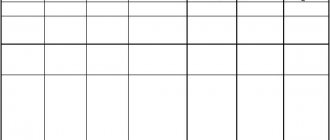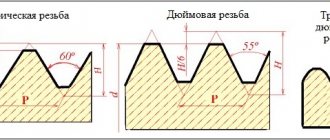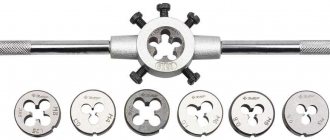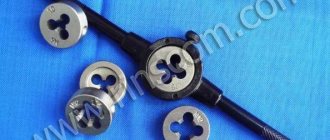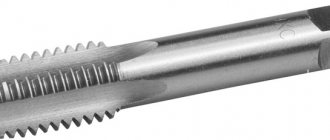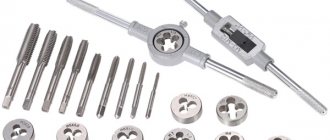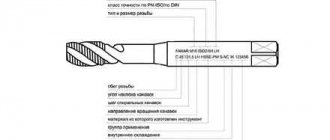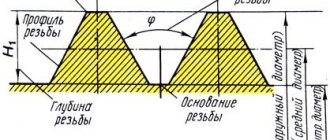Selecting a die for threading bolted joints and pipes will allow you to carry out repair work at home, without the need to call a mechanic. The tool makes it possible to make cone- and cylinder-shaped carvings on prepared metal rods.
Photo No. 1: Metric dies for cutting threads and knobs
Products are made from high-speed steel P18, P9 or alloy steel marked KhVSG and 9ХС (used for the manufacture of tools for working with metal). There are dies of various shapes on sale: round, square, pipe, hexagonal. According to the design of the body, the products are solid, sliding and split.
Another classification is based on the method of thread cutting:
- for the round one there is a tool in accordance with GOST 13536-68;
- cylindrical on pipes - GOST 9740-71;
- conical - GOST 6211-81;
- inch - GOST 6111-52;
- metric - GOST 9150-81.
Most often, specialists need to buy round dies. They make it possible to perform carvings in 1 pass. Compare: a sliding type tool requires 3-4 passes to achieve a similar result. However, round products do not allow achieving high accuracy (no higher than class 2). This should be kept in mind when choosing a tool.
Types of dies for thread cutting
Let us list the main types of dies for thread cutting and their features.
Metric
The tool is adapted for making metric threads (measured in millimeters). Products of this class are marked with the marker M. For example, M9 makes a 9 mm thread. The size of the dies ranges from 1 to 60 mm.
Photo No. 2: 18 mm metric die
In addition, for metric tools, such a parameter as thread pitch (distance between turns) is relevant. The thread pitch is main and additional (it is always less than the main one).
Example. A tool with an M12 marker has a main thread pitch of 1.75 mm and several additional ones: M12*1.5, M12*1, M12*0.75, M12*0.5. The smaller the number indicated on the marking, the closer the turns are located to each other.
Table No. 1: Thread pitch for metric dies of different sizes
Left
Selecting a die for cutting left-handed threads is usually required when making rotating joints. The products are used quite rarely. Basically, if there was a right-hand thread, the connection would come loose. The drill chuck is tightened with a left-handed screw. Products are marked LH.
Photo No. 3: Metric left-hand 14 mm die
Pipe
To make it easier to distinguish from metric tools, pipe tools are designated with a marker G. Such products are needed for carving pipes. Threads here are measured in inches. The conversion table will help you convert millimeters to inches.
Table No. 2: Metric left-hand 14 mm die
Example. G ½ and G ¾ dies cut threads into half an inch and three quarters of an inch, respectively. These tools are the most common and are suitable for making pipes in hot and cold water supply systems. Product sizes range from 1/8 to 2 inches.
Pipe conical
Used for making taper threads. Found application in the production of heating systems and machine tools. The product marking contains the letter K.
Photo No. 4: Pipe conical die
Profile
According to the profile, there are metric, pipe inch dies, and trapezoidal threading tools. Each variety has its own characteristics:
Metric. As the name suggests, they cut metric threads. They are designated by the letter “M”, followed by a number indicating the thread diameter in millimeters. The standards provide for sizes up to 68 mm, each corresponding to a small or large step. Dimensions, designation examples, acceptance rules for such dies according to GOST 9740.
Read here: How to make a pipe bender with your own hands: drawings, examples of creation and construction options
Pipe cylindrical. Visually easy to identify by the letter “G” on the body. This type of thread is measured using the English inch unit, which is 25.4 mm.
So, the designation G 1/2” means that we have a half-inch pipe thread. They are widely used for pipes of heating equipment and water supply systems. Size range from G 1/8” to G 2”.
Pipe conical. In order not to confuse them with other varieties, they are marked with the symbol “K”. They are used when it is necessary to obtain a conical threaded surface - in critical connections operating under pressure or machine components.
Trapezoidal. The cross-section of the threads is an equilateral trapezoid. They are common in power pairs that convert rotation into translational motion. The simplest example is the lead screw and nut of a machine and bench vice.
How to make carvings using a die
A pipe threading die, a wrench and a pipe clamp are tools that are required when working with piping systems. To select a left-handed/right-handed die, evaluate the markings. If there is a letter designation LH, you have a tool for left-hand thread.
Photo No. 5: The process of cutting threads on a workpiece
After the preparatory issues have been resolved, proceed to processing the workpiece. To do this, go over the part with a file and lubricate the joint with oil. Next, insert the tool into the driver and the workpiece into the clamp. Place the die on the product and perform several turns at the rate of 2-3 in the desired direction, half a turn in the opposite direction. During operation, the tool must be positioned perpendicular to the workpiece.
To achieve maximum thread accuracy, use a split-type die. This tool has locking screws, which allows you to control the diameter of the thread while cutting it.
Read also: Stepper motor 6 wires connection
A thread tap is a tool used to create permanent connections. Manufactured in the form of a screw rod. Its shape can be cylindrical, conical, uterine, in the form of a die - these are the main types of taps existing in mechanics. The shapes depend on the type of thread being cut. Either three or four grooves are made on the longitudinal sides of the rod.
Design
The first feature that distinguishes one lehr from another is the design of the body. In accordance with this, they distinguish:
- Round dies. The body is a solid ring through which the workpiece passes. Thanks to high rigidity, a high-quality thread with a good thread profile is obtained.
- Sliding dies, consisting of two parts, are designed to produce threaded surfaces of various diameters.
- Split - the range of thread diameters is 0.1-0.3 mm. Therefore, it is advisable to use them for imprecise threads.
Design features
Let's take a closer look at what a tap is. The screw rod, which is the GOST 3266-81 tap, consists of a working section and a shank. The purpose of the shank is to securely fasten the tool. When machining parts, it is installed in machine chucks. Manual cutting of threads is carried out when the tap is inserted into the driver and screw movements are made clockwise.
The tool shank is installed with the head into the hole of the square driver.
The section of the tap that directly cuts the threads is called its working part. It consists of an intake and calibrating part.
The tapping section of a thread cutting tool is the tapered area at the front of the screw that begins and secures the initial threads. The calibration section is designed as its completion.
Purpose
Cutting feathers are made in the form of teeth, having the configuration of mechanical cutters, which have all the elements for metal processing. They cut the main thread pitch, located along the entire circumference of the tap. Grooves are longitudinal grooves between the cutting feathers.
These components form the cutting edges. Chips are removed through them and coolant circulates. Taps with an outer section of up to 20 millimeters are produced with three grooves, those with an outer section of up to 20 and up to 40 millimeters are produced with 4. The structural design of each is predetermined by its functional purpose.
In practice, a tap is a screw with grooves on the outer planes. The GOST tap with helical grooves is much more important than its counterpart with straight grooves. The screw structure of the tool provides more favorable conditions for thread cutting. They are preferable due to the following characteristics:
- Cutting complex threads.
- Particularly precise work.
- High quality workmanship.
- Better removal of chips.
- Experience less temperature influences.
So, what types of taps are divided into? There are two big directions:
- cutting threads inside the part;
- external cutting: purlins, dies, screw-cutting boards.
- machine tools;
- for manual locksmith operations.
The industry produces sets of hand-made thread cutting products. GOST for taps for metric threads stipulates that any set should include two or three tools.
Each must have its own individual purpose. In the set they are called: first, second, third.
With regard to the location of the longitudinal grooves, threading tools are classified as helical and straight.
The most accurate thread is obtained when it is made with a screw. Left-hand threads are cut with a left-hand thread tap, and vice versa.
Manufacturing and labeling
In some cases, manufacturers mark their products with numbers 1, 2, 3. Sets for two taps are made with a slightly larger cross-section of the first rough product.
Industrially produced kits:
- cross section 8-18 mm – one piece each;
- cross section 6-24 mm – first and second;
- cross section 2-52 mm – first, second, third.
- 5/16–3/4" – one piece each;
- 1/4–1" – one rough and one finishing per set;
- 1/4-2" - one rough, one medium, one finishing per set.
For pipe threads with a cross-section of 1/8-4" the kit includes one first number and one second number.
Taps for thread cutting. Table of main characteristics
| Thread | Hole cross-section, mm |
| M1.0 | 0,75 |
| M1,2 | 0,95 |
| M1.4 | 1,1 |
| M1.7 | 1,35 |
| M2.0 | 1,6 |
| M2.3 | 1,9 |
| M2.6 | 2,15 |
| M2x0.5 | 2,5 |
| M3.5 | 2,9 |
| M4x0.7 | 3,3 |
| M5x0.8 | 4,2 |
| M6x1 | 4,96 |
| M7 | 6,0 |
| M8 | 6,7 |
| M9 | 7,7 |
| M10x1.5 | 8,45 |
| M11 | 9,4 |
| M12x1.75 | 10,18 |
| M14 | 11,8 |
| M16 | 13,8 |
| M18 | 15,3 |
| M20 | 17,3 |
Metal for making
For various types of dies, taps, and other metal-cutting tools, carbon steels of popular grades U10A and U12A are used. They are hardened to obtain a hardness of HRC 60-62 units. This indicator makes them the most resistant when cutting metal and other hard materials.
Read also: Drawing with a wood router
Much better red-hardness indicators are found in tool steel with the addition of alloying elements:
Metal-cutting tools made from a similar material, for example, a die for cutting threads or a broach tap, have higher cutting properties. Machinability is much better than carbon steels. Red resistance with alloying additives also has excellent performance.
External thread cutting with a die
To cut external threads, you will need the following tools and materials: a die or pipe clamp, a die holder, a file, a vice, a caliper, and machine oil.
The most widespread are round dies (lerks). They are either solid or split. The diameters of solid round dies are standardized. This allows you to choose the appropriate option from a large range of sizes, for example, M10, M12, M14, M16.
Methods for connecting products to each other
The connection of parts, assemblies, and mechanisms with each other is used in all areas of industry and the national economy:
- machine-building enterprises;
- machine tool manufacturers;
- oil and gas sector;
- light industry;
- food industry.
There are many ways to connect different parts of machines. The most common ones are:
- welded joints;
- gluing methods;
- curing;
- assembly with rivets;
- threaded bolts and nuts.
The last method is the most universal, simple, and inexpensive.
How to cut threads yourself
First you need to prepare materials and tools:
- electric drill;
- drill of the required section (select from the table);
- standard set of taps;
- knob with clamping square;
- core, vice;
- hammer 300 g;
- lubricant;
- rags, rags.
Step-by-step instructions on how to cut a thread with a tap:
- Mark the space for the hole on the part. Place the core at the intersection of two lines.
- Mark the location for the future hole with a strong hammer blow on the core.
- Clamp the drill into the chuck of an electric drill, set low speed, lubricate the drill, and drill a hole.
- Use a larger drill bit to remove the chamfer.
- Insert the roughing tap with the square head into the hole in the driver and clamp it with two handles.
- Rotating the knob with both hands, cut a thread, M12 is the main thread pitch.
- To check the quality, screw an M12 bolt into the cut thread. It should not twist tightly, but at the same time, not hang out in the thread.
Movement algorithm: two turns forward, one in the opposite direction. It is recommended to work with little force. If the tool gets stuck in the metal, make a few movements back. Periodically lubricate the surfaces while continuing work. Repeat the operation with the middle and then the finishing tap.
It is best to lubricate the threads when cutting with old lard.
Tapping internal threads
To form an internal thread, the following tools and materials are required:
- hammer, center punch, drill, drill bits;
- a set of taps, a driver, a bench vice;
- machine oil.
Tapping technology
The first step is to mark the workpiece and core the center of the future hole. Select a drill corresponding to the required thread diameter. This can be done using lookup tables or approximately using the formula d = D – P. Here D is the thread diameter, P is its pitch, d is the drill diameter. For example, for M10 d = 10 – 1.5 = 8.5 mm.
A hole is drilled into the part to the required depth, which must exceed the length of the part being cut. Using a drill with a diameter larger than d, a chamfer is made on the edge of the hole. It serves for centering and better entry of the tap.
The cutting tool is selected based on the main parameters of the thread - diameter and pitch. As a rule, a set of two taps is used. One of them is rough, the other is finishing. The driver is selected according to the size of the square of the tail part of the taps.
The part is securely secured in a vice. The rough tap and hole are lubricated with machine oil. After this, install the tap strictly perpendicular to the surface of the part and, pressing along its axis, rotate the knob by the handles.
After cutting one or two threads, make a quarter turn in the opposite direction. This promotes chip crushing and removal and prevents tool jamming. The work continues, carrying out alternating rotation: ½ turn forward, ¼ turn back. In this case, it is necessary to ensure that there is no skew of the tap. You should also not apply excessive force to it. To prevent jamming, the cutting tool is periodically removed and the hole is cleared of chips.
What to do with a broken tap
When performing manual threading, sometimes the blind hole tap is broken. It's not difficult to unscrew it back. There are several ways to do this.
- If there is a long piece of debris sticking out of the hole, you need to grab it with pliers, hold it in a vice, and unscrew it counterclockwise.
- Insert a piece of thick wire through the groove of the tap, bend the edges and unscrew the rest of the tool counterclockwise.
- Break the remaining fragment by hitting a hardened core with a hammer and remove the fragments with tweezers.
- Heat the part with the fragment in the oven, let it cool together with it, and drill out the annealed tap.
- Weld a mandrel with pins whose diameter will fit into the grooves of the broken tool. Unscrew it clockwise.
- Weld a bent steel rod to the piece and unscrew it from the hole.
Cutting threads with your own hands is easy. This will require a minimum of tools and materials. Each time before carrying out work, you need to familiarize yourself with the reference data from the table for threading in order to make a hole of the required diameter with the correct pitch.
Die holders
To cut a thread, one tool is not enough. You will also need an auxiliary device for clamping and holding the die body - a die holder.
One device is designed for several standard sizes at once - for small, medium and large threads. The die is installed inside the holder and secured with a screw.


